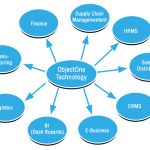Choosing an EDI solution
EDI (Electronic data interchange) is a broad term encompassing pretty much anything used to help connect buyers with sellers. Broadly speaking you can break this down into B2B and B2C segments. B2C ones are usually called things like e-commerce, online shops etc. B2B interactions are usually regulated under an industry standard within the EDI umberella. for e.g. PIDX for the petroleum industry, CIDX for chemicals, X12 and EDIFACT are general purpose (largely used in the retail/wholesale segments). My focus for this article remains the B2B segment given my prior experience, however its overlap and shift towards a B2C consumerization is also a key trend to follow.
Within the B2B EDI space, two broad umberellas seem to label initiatives. Order to Cash (O2C) and Procure to Pay (P2P), the former being more supply chain and the later usually focusing on an E-invoicing solution. Functionally EDI usually cover the following to digitize the supply chain :
- Purchasing
- Vendor Management
- Product listing
- Bidding and contract regulation
- Quotes, prices, availability
- Inventory (movement, status, returns)
- Logistics (shipment, delivery)
- Finance (PO, Invoices, Payments, etc.. )
However VERY rarely have I seen all these get implemented.
There are some 90,000+ individuals out there with jobs associated with EDI and tools to match many people. Most products in this space rely on the value of the network (square of the size of the network) as a core business value use-case: i.e. “connect to us and you are connected to everyone in your industry” (or so the story goes). Most have moved quickly to onboard dominant players in their respective industries and then worked their way backwards to smaller suppliers and customers from there. I enlist basic features here which I will try to elaborate in a later article. Based on the discussion above, if one were to construct a super-set of features your EDI solution should have, you’d end up with the following list. Again, very rarely will a single tool include everything however the list serves as a good reference to identify gaps in a vendor’s offering and to plan out a road map for implementation and enhancements:
- Integrate sourcing and procurement: The solution offers a centralized dashboard where suppliers, customers and internal staff can log in to view all invoice and order related activity. This includes working documents like invoices, orders, Policies, Team TODOs, Discussions etc. The portal also provides real time data to partners on product catalogs, rates etc.
- Visibility and Reporting: Graphs, charts and KPI dashboards provide visibility into daily developments, exceptional conditions and help identify new opportunities for savings.
- Automated purchase request PR and PO processing: For repeated purchases, the solution enables users to automatically generate draft purchase orders/requests based on rules defined on the ERP /Warehousing system data. The rules can include things like inventory levels, price updates or date scehedules.
- Invoice disputes and resolution: All invoices/orders in the system can be shared with suppliers/customers directly allowing for discrepencies with the invoices to get resolved sooner. Invoices can be re-assigned internally for faster resolution and action. Any comments are tracked and all changes audited. Status updates from the supplier’s / customer’s system are available on the dashboard (e.g. “Under-Review”, “Accepted”, “Paid”) allowing for unprecidented visibility into the state of the invoice.
- Supplier Management: The portal can optionally support user self-registration to streamline the onboarding process for vendors. You can invite multiple vendors for product auctions and process selected vendors. The portal supports contract management and supports workflow driven processing of all steps in the vendor onboarding process. Sales processess can include developing sales quotes, attaining approvals, checking product availability, creation of sales orders, good issue, customer invoicing, and management of the commissions process.
- Integrated: The solution supports connectivity with a diversity of ERPs, B2B EDI standards. It also supports connectivity to cloud gateways that enable connection to several vendors at a time:
- Support for a wide range of Industry Standards:
- Back-end Systems:
- ERPs , xRMs: EPICOR, ADP Taxware, Dynamics, SAP, Sage X3, Oracle EBS, Sales force, SugarCRM, AccountMate, PeachTree, Quickbooks
- IBM: DB2, Mainframe CICS, MQ Series
- Banking: MiSys Equation, TCS BANCS, BankTrade
- E-Commerce Gateways: ADP Open Invoice, Cortex , Elemica, LinkedIn, Facebook, ADP, Basware
- The system can also be integrated to online order catalogs from partner sites for real-time metadata exchange.
- Document Management Systems to store, version, collaborate on, restrict access to invoices, Invoice support documentation etc.
- Workflows: Support for complex workflow implementations. Automation of workflows, especially financial ones generally require an orchestrated business process to be completely hands off. Ideally state based workflows should be supported since that is how invoices workflows usually are.
- Printing integration: The vast Majority of integration (especially invoicing) is done through printed documents over snail mail. Secure printing and Integration is one of the key features of modern EDI solutions
- Metadata Management: From Account codes to units of measure translation, these modules let users map codes between customers and suppliers.
- Security and Access control: The ability to restrict access to documents, document types or segments of documents within your team is essential.
- Future proofing: A lot of the tools out there are built by small companies with proximity or intimacy to customers and their market. Several of the public ones we studied however are financially constrained or unstable. This makes them bad choices. When choosing a vendor, make sure they are financially stable and have a solid growth / development plan that can last you a few years. As always, try to avoid getting locked in with specialized hardware/software.
- Cost: there are many variations of this out there namely,
- Capex heavy project implementations,
- Product Centric (install + per-customer + annual maintenance)
- Lease and Per-use versions of the above
- End to End “Managed Solutions”
I will discuss these further in a future article soon.







